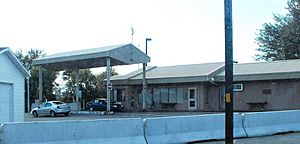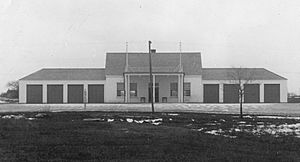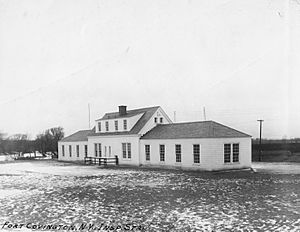Fort Covington–Dundee Border Crossing facts for kids
Quick facts for kids Fort Covington-Dundee Border Crossing |
|
|---|---|

Dundee, Quebec Canada Border Inspection Station
|
|
| Location | |
| Country | United States; Canada |
| Location |
|
| Coordinates | 44°59′53″N 74°30′28″W / 44.997968°N 74.507795°W |
| Details | |
| Opened | 1844 |
| US Phone | (518) 358-2444 |
| Canadian Phone | (800) 461-9999 |
| Hours | Open 24 Hours |
|
U.S. Inspection Station–Fort Covington, New York
|
|
| Lua error in Module:Location_map at line 420: attempt to index field 'wikibase' (a nil value). | |
| Location | Dundee Road, Fort Covington, New York |
| Built | 1933 |
| Architect | Office of the Supervising Architect under Louis A. Simon and James A. Wetmore |
| Architectural style | Colonial Revival |
| MPS | U.S. Border Inspection Stations MPS |
| NRHP reference No. | 14000575 |
| Added to NRHP | September 10, 2014 |
The Fort Covington-Dundee Border Crossing connects Sainte-Agnès-de-Dundee, Quebec, in Canada with Fort Covington, New York in the United States. This important crossing is part of the Canada–United States border. You can reach it using Quebec Route 132 on the Canadian side and Dundee Road on the American side.
This border crossing is special because the international boundary once went right through a building called Taillon's International Hotel. At this hotel, you could stand in Canada and play pool in the United States at the same time! The hotel was built in 1820. This was before the Webster–Ashburton Treaty of 1842, which officially set the border in this area.
Before the current border station was built in Dundee, Canadian customs operated from the McMillon Residence. The current US border station was built in the mid-1930s. In 2014, the US border station was added to the National Register of Historic Places. This means it's recognized as an important historical site.
Contents
The US Border Station at Fort Covington
The US border station at Fort Covington is a key part of this crossing. It helps manage who and what enters the United States.
What Does the Border Station Look Like?
The Fort Covington Border Inspection Station is on the west side of Dundee Road in Fort Covington, New York. It sits on a large piece of land, about 188,000 square feet. The station is in a farming area, with open fields to the east and farms to the south. The Salmon River is about 100 feet west of the building. You can see the Canadian inspection station from here, just to the north.
Cars drive to the station using an oval driveway from the road. Even though it's surrounded by fields and the river, the station has a formal garden design. There are evergreen trees around the sides and back. Also, large hardwood trees grow along the river's edge. North of the station, there's a docking area on the river for boats. Signs tell boaters where the border is. A walkway leads from the boat dock to the station. There's also a parking area for cars south of the building.
The station building has three parts. The middle section is one and a half stories tall and made of white painted brick. It has a steep, end-gable slate roof. On the west side of the roof, there's a shed-style dormer window. There is also one brick chimney inside. The first-floor windows are 12/12 vinyl, and the second-floor dormer windows are 8/8 vinyl. The main entrance on the east side has a glass and aluminum door with side windows and a top window.
Two single-story wings made of weatherboard are on the north and south sides. These wings have hipped, slate-covered roofs. The south wing was used for inspecting vehicles. The north wing was a garage for government vehicles. Some parts of these wings have been changed over time. For example, some garage bays are now enclosed, and new garage doors have been added.
A two-lane canopy extends from the main building. It is supported by steel columns. Part of this canopy was made larger in 1972. The section closer to the building still has its original wrought iron railing. At the very end of the canopy, there's an island with a flagpole and another wrought iron railing.
Inside the first floor, there's an entry area with two counters. To the right of the entrance, there are two small bathrooms. A staircase connects the basement to the second floor. To the left of the stairs, an office space was added in 1935. It has a wall with three glass windows and a glass-topped door. The area on the right is open. The inside walls are plaster, and the rooms have classic trim around doors and at the base of walls. The public area on the first floor now has new tile. The original lights have been replaced with modern fluorescent lights.
The basement has a cement floor and is divided into rooms for machinery and storage. The two end rooms have their original decorative doors. The second floor has hardwood and linoleum floors. It includes two detention rooms with original barred doors, sinks, and toilets. There is also an office and a long storage room.
Why is This Building Important?
The Fort Covington Border Inspection Station is one of seven similar stations built between 1931 and 1934 along the Canada–US border. It was designed in the Colonial Revival style. This style looks like older American colonial homes. The building was designed by the Office of the Supervising Architect under Louis A. Simon. It was built in 1933.
These border stations were built for several important reasons in US history:
- Controlling Smuggling: From 1919 to 1933, the US had a law called Prohibition. This law made it illegal to make, sell, or transport alcohol. This led to a lot of illegal smuggling of alcohol across the border. These stations helped stop this activity.
- Creating Jobs: The stations were built during the Great Depression. This was a time when many people didn't have jobs. Building these stations helped create work for local people.
- Handling More Cars: Cars became much more affordable thanks to Henry Ford's assembly line. More people were driving, and more cars were crossing the border. The government needed better ways to check people and goods.
The Fort Covington station is a good example of a smaller, rural border station. Other similar stations are in Chateaugay, Champlain, Rouses Point, and Mooers, New York. Even though these stations have been changed over time, they still show much of their original design. Fort Covington is unique because it controls both land and water crossings.
How the Station Came to Be
During Prohibition, there was a lot of illegal movement of goods across the Canada–US border. In New York, only a few customs officers and border patrol agents tried to stop this. They often worked on foot or horseback. Many US Customs Houses were a mile or so from the border. Travelers were expected to stop there to declare what they bought.
To fix this, the government passed the Elliott-Fernald Public Buildings Act in 1926. This law allowed the Treasury Department to speed up its building program. They set aside a lot of money for new public buildings.
Fort Covington was west of the main "Rum Trail," which made Rouses Point a major spot for illegal alcohol. But Fort Covington was still an important border station. The Fort Covington border inspection station was finished just before Prohibition ended. However, even after Prohibition, smuggling continued. People still wanted Canadian goods, and some people illegally moved alcohol into Canada where it was more expensive. So, Fort Covington kept working to stop this activity.
Although plans for the seven New York border stations began in 1929, getting the land and designing the buildings took time. Construction happened at different times over five years. Fort Covington was one of the last stations to be built. It is still used actively today.
Why it's on the National Register of Historic Places
The Fort Covington Border Inspection Station is important enough to be on the National Register of Historic Places. It has national, state, and local importance.
The station is linked to three major historical events: Prohibition, the Public Buildings Act of 1926, and the rise of mass-produced cars. Even though it was finished just before Prohibition ended, it was designed to fight the widespread illegal movement of goods. It continued to play a vital role even after 1933. The station has been in use for over 60 years.
The Public Buildings Act was planned during a time of good economy. But it became even more important during the Depression. The government sped up funding to help local economies. This created jobs for many unemployed people, both in building and then working at the stations. Local stories show how many jobs the station created. Local workers built it, and Fort Covington residents became customs inspectors.
The Fort Covington Border Inspection Station is also connected to Louis A. Simon. He was a key architect for the US government from 1905 to 1939. He designed hundreds of government buildings. Simon believed in a "conservative-progressive" design approach. He wanted government buildings to look classic and beautiful. The Fort Covington station is a great example of the Neo-colonial style. This style was thought to be a good fit for upstate New York. Its steep roof might even reflect the state's Dutch building style. The building was made with high-quality materials and excellent craftsmanship. It still looks and feels like it did when it was built, showing its original purpose.
Images for kids





